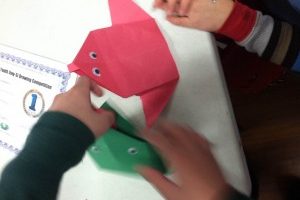Project Title: Origami Frogs, also see our translation 折紙青蛙
Description: Create diverse, paper origami frogs.Frogs are a symbol of perseverance. They wait patiently for flies

Project Ideas: perseverance, patience, naturalistic, recycling
Author: Alysia
Grade level or Target Age Range: Elementary grades 1-5
Historical Art Examples or References: Photos of different frogs in their habitats are helpful. If time allows, this lesson could be coupled with facts about amphibians.
Kidzone – resource for frog activities, facts, and photos
Vocabulary: frogs, origami, diversity, color
Materials: Paper, scissors, plastic bottle lids.
Optional: Coloring materials such as crayons or markers, plastic eyes, glitter, glue etc.
Anticipatory Set: A poem or fun facts about frogs are a good classroom opener. Examples: Did you know that frogs are just as diverse as people? Do you know what an amphibian is?
Demo/Directions: Show and discuss pictures of diverse frogs (this may encourage the students to create freely). You may also talk briefly about the art of origami. (5 minutes)
Proceed with demo. Children can also create along with teacher. (5-10 minutes)
- Cut a piece of paper into a square.
- Fold square in half to make a triangular shape.
- Use tips of triangles to fold inward, forming the frog’s legs.
- glue plastic bottle lids onto frog head to make eyes.
- Discuss and share. (5-10 minutes)
Discussion:
This project can be used for motor skill practice with younger children.
It is also a great project for learning basic origami.
You can also lead a great discussion on patience and things that are worth waiting for.
Instructional Reflection:
This project is great for those that are new to origami because the steps are simple and easily replicated. Smaller children may need assistance with folding. This is also a good group project because older children can assist their younger peers during this process.

